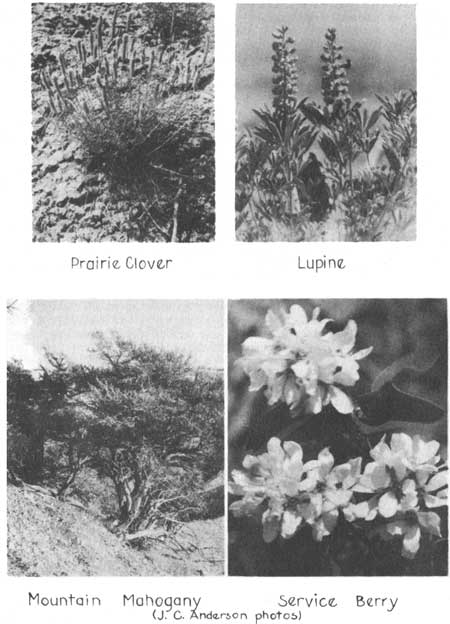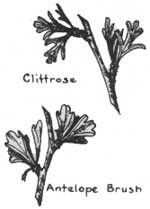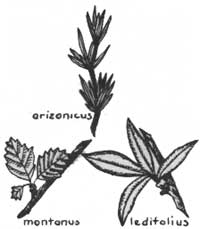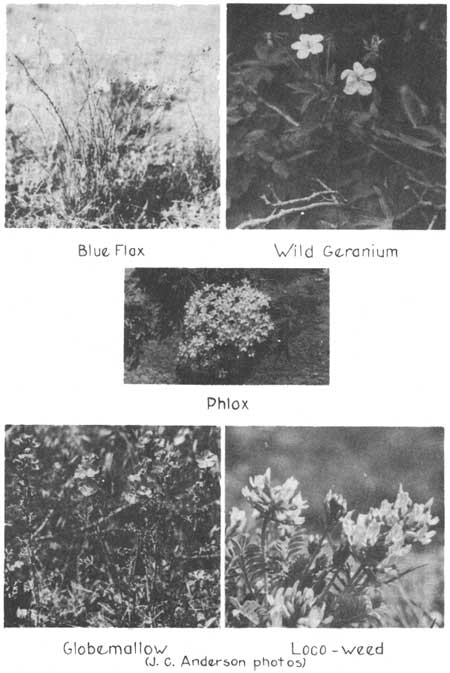|
ZION
Plants of Zion National Park |

|
Zion-Bryce Museum Bulletin
Number 1
PLANTS OF ZION NATIONAL PARK
Families of Plants
(continued)
ROSE FAMILY (ROSACEAE)
This large and diverse family is represented in Zion chiefly by shrubs and small trees; most of them bear little resemblance to the cultivated rose, but some can be recognized by their small, rose-like flowers.
ROCK ROSE, Petrophytum caespitosum. A compact, mat-like, gray-green perennial that is common on rocks and cliffs that often appear too dry to support life. Most easily seen on the Great Arch Trail, or at the reconstructed Pueblo food cache opposite the Great Organ.
OCEAN SPRAY or ROOK SPIREA, Sericotheca dumosa. The common name of this shrub refers to the foamy, creamy-white clusters of tiny flowers which are very conspicuous in June and July. The leaves are small and wedge-shaped, toothed on the broad outer end. It is common above 4000 feet wherever there is moderate moisture.

PLATE VI
CINQUEFOIL, Drymocallis fissa. This perennial herb has been aptly described as "a yellow strawberry blossom, on a very tall stem". It grows about 2 feet tall, with most of the long, strawberry-like, compound leaves at the base. It will be found blooming in July in the cooler parts of the plateaus, as at Potato Hollow. A somewhat similar, but smaller plant, Ivesia mutabilis, grows in warner portions of the Pygmy Forest Belt.
BLACKBRUSH, Coleogyne remosissima. A Lower Sonoran shrub, common in the Petrified Forest and Coalpits Wash. It is well named, having a burned, dead appearance during much of the year, but in late April and May it puts out minute gray-green leaves and yellow flowers.

CLIFFROSE, Cowania stansburiana. A shrub or small tree common above 4000 feet, especially on warm dry slopes among pinyons and junipers, Its cream-colored flowers, appearing in May and June, are suggestive of a small wild rose. The twigs and leaves are a favorite food for deer and other browsing animals.
ANTELOPE-BRUSH, Purshia tridentata, is somewhat similar to cliffrose, but is usually smaller, and has wider leaves and smaller yellow flowers. It grows in much the same situations and is equally valuable as browse. It is one of the many different western shrubs known as "buckbrush".

MOUNTAIN MAHOGANY, Cercocarpus montanus. (Plate VI) A large shrub, or rarely a small tree; one of the more common species in the chaparral above 6000 feet, usually in the dryer locations, where it is sometimes the dominant species. Another species, Cercocarpus ledifolius, often grows to be a small tree, and sometimes forms pure stands on the higher south slopes, as on the south edge of Horse Pasture Plateau. It is not quite so common as montanus. Along the Great Arch Trail, Cercocarpus arizonicus has been collected. It is the least common of the three species in Zion, but may be found scattered throughout the Upper Sonoran Zone. All our mountain mahoganies have value as browse, and their dead wood makes a very hot fire.
WILD RASPBERRIES are found in a few of the cool canyons, as the Grotto, but are not common. The black-fruited kind is Rubus leucodermis; and at the north base of Angels Landing a rare white-fruited form, Rubus leucodermis leucocarpa, was discovered by Dr. A. M. Woodbury in 1928, and named by Mr. C. V. Morton, of the U. S. National Museum.
Two kinds of WILD ROSES grow in the park: Rosa granulifera, leaves minutely hairy on the undersides, found on the plateaus and cooler parts of the Upper Sonoran Zone; and Rosa malina, leaves narrower and smooth on both sides, found in the coolest canyons.
APPLE FAMILY (MALACEAE)
A few SEEDLING APPLES, Malus pumila, are present in Zion Canyon, escapes from the pioneer farms.
SERVICE BERRY bushes are common in the chaparral everywhere except in the Lower Sonoran Zone. They are especially noticeable in early spring, since they leaf out and produce blossoms (white and abundant) a week or more in advance of all other shrubs, (Plate VI). Amelanchier utahensis is the most common kind, distinguished by its small, nearly round leaves, and dry yellow berries. Amelanchier pallida closely resembles it, but the leaves are more oval. Amelanchier alnifolia has larger, rounded leaves, sometimes one inch across, and juicy purple fruit that makes excellent pie. However, it is vary seldom that any of our service berries produce a good crop of fruit, since both fruit and leaves are badly infested with three kinds of rust (Gymnosporangium inconspicuum, G. nelsoni, and G. juvenescens), which produce spores that infect both Utah juniper and Rocky Mountain red cedar. After doing some damage to the leaves and twigs of these trees, another crop of spores is produced which reinfect the service berries. This arrangement of alternate hosts has a parallel in the well known white pine blister rust, which is much more destructive than the juniper and cedar rusts.
SQUAW - APPLE, Peraphyllum remosissimum, A rather rare shrub in Zion, being known only from the Eaat Rim. It grows about five feet high, has narrow round-tipped leaves (1 inch long) borne in clusters at the ends of short twigs, pink blossoms, and small very bitter apples.
PLUM FAMILY (AMYGDALADEAE)
CHOKECHERRY, Prunus melanocarpa. (Plate V). A small shrub, easily recognized as a cherry, bearing clusters of white blossoms later replaced by bitter black cherries. Found on the plateaus, usually in good soil. The stems are usually infected with a black canker, similar to that on cultivated cherries.
MIMOSA FAMILY (MIMOSACEAE)
HONEY MESQUITE, Prosopis glandulosa. A Lower Sonoran Zone tree, uncommon in Zion at Coalpits Wash and the lower end of Parunuweap Canyon. Its compound leaves, bean-like seed pods, and sharp spines remind one of a locust tree. It is a valuable source of honey, and the beans are nutritious food for many animals, and even human beings.
PEA FAMILY (FABACEAE)
One of the largest and most easily recognized plant families, distinguished by having flowers like those of the sweet pea. They are very irregular, with 5 petals; one large fan-shaped petal at the top, two at the sides forming "wings", and two below joined to form a "keel".
The LUPINES are easily recognized by their leaves, palmately compound (like ribs of an umbrella) with five or more divisions. (Plate VI). All of our kinds have silvery hairs on the foliage, and purple blossoms. Lupinus caudatus is the largest in Zion, about two feet high; it grows on the plateaus. Three other kinds, seldom over 6 inches high, and densely silvery haired, grow below 7000 feet: Lupinus arizonicus, Lupinus shockleyi, and Lupinus rubens. The last one has bi-colored flowers, purple and yellow.
A FALSE LUPINE, Thermopsis pinetorum, with yellow flowers and three-parted leaves (rather than 5 or more, as in true lupines) grows on the plateaus, blooming in late June.
Three cultivated members of the pea family have escaped from early-day farming operations and are mow rather common in Zion and Parunuweap Canyons, especially along ditch and stream banks: ALFALFA, Medicago sativa; WHITE SWEET CLOVER, Melilotus alba; and YELLOW SWEET CLOVER, Melilotus officinalis.
CLOVER is not very common in the park. In the Lower Sonoran Zone, and slightly above, is a white clover, rather tall and slender, Trifolium macilentum. A smaller, creeping white clover, Trifolium rusbyi, with small round leaves, similar to that used in lawns, grows in suitably moist locations in the cool canyons and on the plateaus, Trifolium parryi is another plateau species, with tall erect stems, narrow toothed leaflets, and purple flowers slightly smaller than common red clover.
TREFOIL or LOTUS is a small pea - vine with narrow leaflets, usually in 3's, and yellow flowers like miniature sweet peas. The following kinds are known to occur in Zion Park: Lotus torreyi, Lotus argensis, Lotus wrightii, Lotus mummularius, and Lotus longe-bracteatus. The last species is most common, being found throughout the park above 4000 feet. Its flowers turn red as they wither.
SCURF - PEA, Psoralea stenophylla, has been collected on the sandy river bank in lower Zion Canyon. It is a tall, slender-stemmed perennial pea, with white flowers, and narrow rough leaves in 3's, 4's, or 5's.
DESERT BEAUTY, Parosela johnsoni. A small shrub with light gray bark, small gray-green leaves (pinnately compound) and terminal spikes of brilliant purple flowers. In Zion it is confined to Coalpits Wash and Shunes Creek, but in adjacent low deserts it is vary common. In Houserock Valley, for example, it forms an extensive and beautiful flower display in June.
PRAIRIE CLOVER, Petalostemon rothrockii. (Plate VI). A tall plant, very noticeable when in bloom, in June (purple flowers). It is most common at Shunes Creek, but also grows in Coalpits Wash and the lower end of Zion Canyon.
SOUTHWESTERN LOCUST, Robinia neo-mexicana luxurians. A small tree, seldom over 20 feet tall, heavily armed with short spines, with large drooping clusters of pale rose-colored flowers appearing in late May and June. Common in Zion Canyon; also found in other large canyons in the park. BLACK LOCUST, Robinia pseudo-acacia, has escaped from early-day cultivation, in lower Zion Canyon.
Petaria thompsonae, a spiny perennial with light yellow flowers, has bean collected in Coalpits Wash. Its range is limited to southern Utah.
LOCO-WEEDS are common in Zion, especially at lower elevations. (Plate VII). Some of the larger species have inflated seed pods that rattle when shaken, hence the name RATTLEWEED. All have pinnately compound leaves, with the leaflets usually rather closely crowded together. Most are poisonous to stock, but some seem to be comparatively harmless. Those known to occur in Zion are: Astragalus allochrous, Astragalus araneosus, Astragalus flavus, Astragalus confertiflorus, Astragalus amphioxys, Astragalus zionis, Astragalus glareosus, and Astragalus sabulosus. The last species is the one most commonly known here as RATTLEWEED; it is a rank growing, white-flowered kind, very common at lower elevations.
LICORICE, Glycyrrhiza lepidota. A tall, leafy perennial with cream-colored flowers, and small, reddish-brown seed pods thickly covered with prickles. Found in Zion Canyon, in deep soil; not common.
Of all the members of the pea family in Zion, only three produce climbing tendrils. These are two VETCHES, Vicia americana, and Vicia oregona, and a PEA, Lathyrus encosmus. All are trailing or climbing vines with purple flowers, but can be distinguished as follows: The Pea has sharply pointed leaflets; the Vetches have round-ended leaflets, those of oregona are slightly hairy, those of americana smooth.
GERANIUM FAMILY (GERANIACEAE)
WILD GERANIUM, Geranium fremontii, (Plate VII) Very similar to a simple cultivated geranium, having five veined petals, light purple, and deeply lobed hairy leaves with the characteristic geranium odor. Common on plateaus and in cool canyons, as on the Narrows Trail, blooming in July.
FILAREE, Erodium cicutarium, A small "weed" with finely divided leaves and small purple flowers, growing close to the ground in open meadows and flats in all the larger canyons. It is one of the earlier blooming species in Zion; and since it grows so abundantly on the flats along the Virgin River, both inside and outside the park, it often presents in March or early April the appearance of a pale purple lawn.

PLATE VII
FLAX FAMILY (LINACEAE)
WILD FLAX, Linum lewisii. (Plate VII). In May and June the trailsides on the plateaus and in such cool canyons as at Emerald Pools are beautified by the delicate blue flowers of this species. They are nearly an inch across, with five petals, borne at the top of a slender stem having very narrow leaves. It is not nearly so common here as at Bryce.